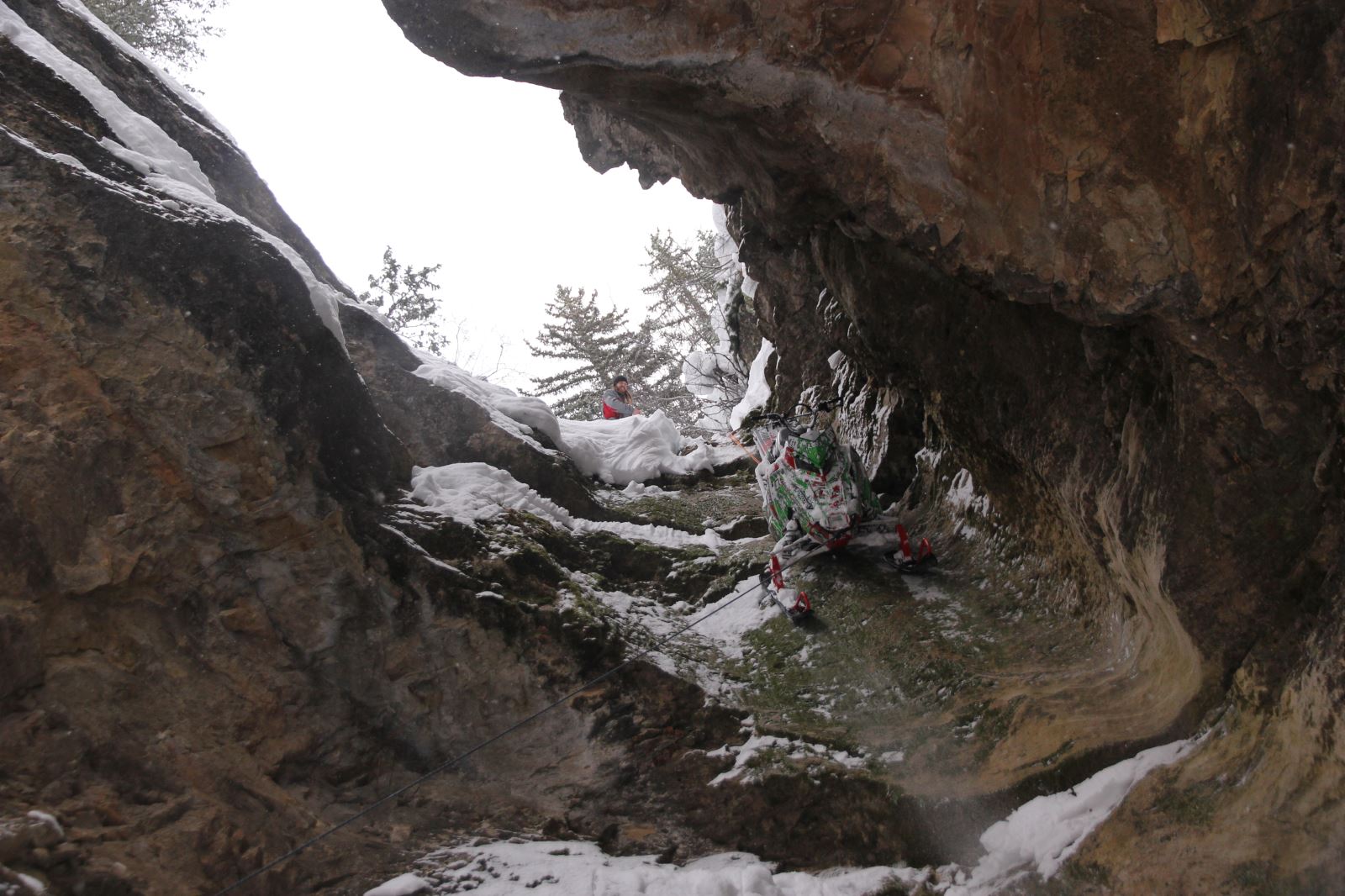
LONG WALK
Ryan pulled up next. When I told him that we were walking out, he briefly thought I was joking. Then a look of dismay came over his face. I felt horrible for leading my friends into this situation. We turned our attention to deciding what to pack with us and quickly got on the way. In order to get around the waterfall and surrounding cliffs, we had to hike several hundred feet up one side through the trees and traverse around to a steep chute that dropped us back into the bottom. Once at the bottom of the falls, I saw that the waterfall was even larger than it appeared from the top, around 60 feet, and surrounded by cliffs much larger than that on both sides. The only way to get our machines out would be to lower them down the waterfall. "It is what it is,” I said, there was nothing we could do now but walk out and make a plan to come back later. On the positive side, there was no running water in the creek bottom here.
I guessed that it was one to two miles to the main canyon bottom where we would hit a snowmobile trail, and then just another couple miles from there to the truck. It was rough going walking in the creek bottom though. The snow was punchy and deep, we sank to our thighs with every step. Each of us was carrying at least 30 pounds of gear including our packs, food, helmets, survival gear, etc. The extra weight did not help, but we were not about to leave anything we might need back at the sleds. Although the three of us were all in good physical condition, the progress was excruciatingly slow as we pushed down the creek bottom. Slow and steady was our mantra. Better to maintain a manageable pace and avoid sweating or hitting a wall. We would have been lucky to average one mile per hour through this untouched creek bottom.
I thought I knew exactly where we were, yet a series of negative thoughts quickly went through my mind here. “What if it is much farther than I think it is to the bottom? What if we are not even in the right canyon? What if one of the guys can’t make the hike out?” These what-if thoughts did not last long––the bottom soon came into view and we were in the right place. After an hour of slogging the mile down the creek bottom we finally reached the main canyon and the packed snowmobile trail. I have never been so grateful to find a packed trail! Once we hit the trail, we were flying, or at least it felt like it after moving at a snail’s pace for the last hour.
Walking out in the dark that evening I had plenty of time to think about my decision-making and where I went wrong. First, I realized the folly in relying solely on topo maps with 40 foot contour lines in order to judge riding terrain. As we found, there can be a lot of variation in between 40 foot contour lines. Second, I cursed myself for venturing into an unknown canyon towards the end of the day with tired riding companions.
As we walked out under the stars a pack of coyotes howled a short distance across the river. The surrounding peaks towered in the moonlight. Despite our circumstances, it was hard not to appreciate this moment. I was thankful that we were prepared for such an occurrence, everyone kept a cool head throughout. I pushed our pace down the trail. Not out of necessity but simply in the hopes of getting out before anyone started to be concerned about our whereabouts. As I thought about this, I vowed to finally pick up a GPS messenger.
Happily, we reached the trucks at 9:30pm, well before anyone would start seriously worrying about us and in significantly less time than I judged the hike out would take. It took two-and-a-half hours to cover just over four miles, at by most measures a crawling pace, but a genuinely impressive feat given the conditions.
Once we got into cell range I posted a message to our riding crew asking if they had any ideas on the best way to lower a sled off a 60-foot waterfall. After responses such as “Shane Kynaston will ride them out for you,” “Push them off,” and “Pin it,” it became clear that we needed the help of a professional climber. Fortunately, my brother Lj Whitmore is a strong rock climber and told me that he could set up a system to safely belay the sleds down the waterfall. We also enlisted the help of Mark Staples. Mark is the new director of the Utah Avalanche Center, incredibly knowledgeable in all things mountains, and also a wicked rider. The recovery team was rounded out by some of the Boondockers crew—myself, Nick Reedy, Shane Kynaston, and Zak Collings. Within an hour of getting down that evening, we had assembled a crew, gathered the necessary equipment, and made plans for a recovery the next morning.